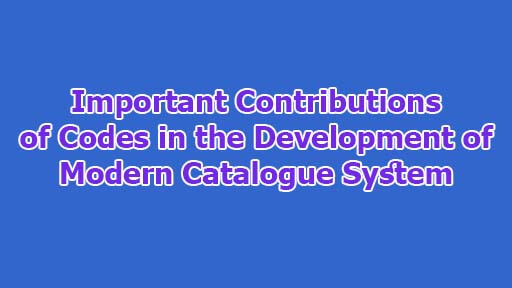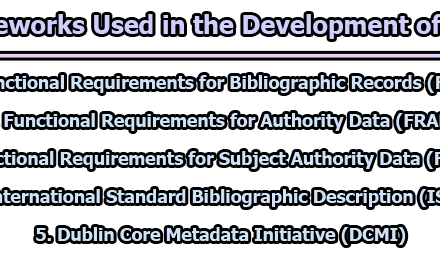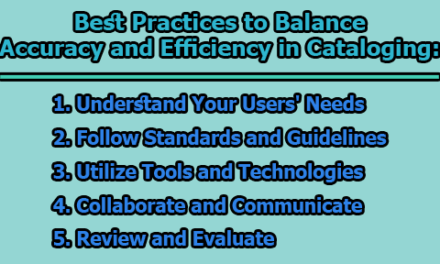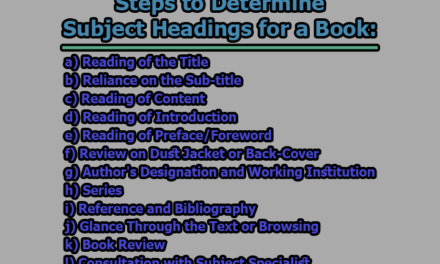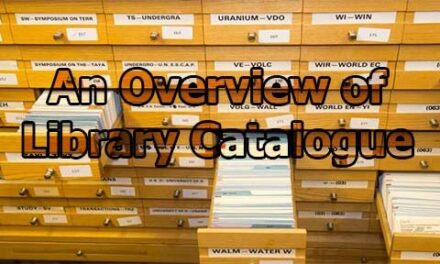A library catalogue code, one or two of which may have surely become familiar with to some extent, can be explained as a `set of rules’ for the guidance of cataloguers in the preparation of descriptive bibliographical records (i.e., entries in library catalogues, bibliographies and. similar other lists) for books and other graphic materials so as to ensure consistency and uniformity in their treatment. The code may additionally have rules for subject cataloguing/indexing and filing of entries as well. Generally, codes comprise rules for the description of materials and choice of headings and their forms needed in making author, title, etc. bibliographical entries including cross-references as may be warranted. This is normally so with codes designed for author-title alphabetical catalogues in which subject entries with appropriate cross references serving as syndetic devices are also filed as in the dictionary catalogue. In the rest of this article, we are going to show some of the important contributions of codes in the development of modern catalogue system.
Modern Catalogue System:
The 19th century was an age of great many codes: Catalogue was considered a finding list with the Bodleian concept of literary unit occasionally given expression in compilations. There ensued a spate of debates on the relative merits of author, dictionary, classed and alphabetical-classed catalogues. Author (under surname) and title (for anonymous work) entries constituted the author catalogue. From this author, catalogue did develop the dictionary catalogue. It consisted of duplicate entries under authors, titles, subjects and forms. For example, the catalogue of the printed hooks of the Society of Antiquaries of London (1816), supposed as the first true dictionary catalogue, employed a duplicate entry approach in one single alphabetical file. The classed catalogue was limited to the subject arrangement in a systematic order by grouping related subjects together or in proximity. As the purpose of the catalogue became better clarified, the classed catalogue gained importance. It applied the systems of classification schemes devised by Bacon, Horne, Brunet and others. The alphabetical-classed catalogue too became popular during the middle of the century. It was rather an amalgam of dictionary and class catalogue. The first half of the century was, thus, characterized by a variety of combinations of arrangements and indexes, broadly divisible into two categories. The first category constituted lists arranged in subject or classed order, i.e., broad subjects or classes in shelf list order with works sub-arranged according to accession and chronologically by imprint date, title or author. The second category consisted of alphabetically arranged indexes to classified files which was not a systematic one. The supplementary alphabetical subject indexes created the need for standard lists of subject headings as aids. Since the practice of picking up subject words from the title lacked uniformity and made syndetic structure difficult, the adoption of a better system especially needed for the construction of a dictionary catalogue was felt. This initiated efforts towards the development of standard lists of subject headings. The ALA published such a list entitled, List of Subject Headings for use in the dictionary catalogue in 1895. It was considered a standard list suitable for all types of libraries and found wide acceptance. The third and final edition was brought in 1911 when the Library of Congress List of Subject Headings (issued in 3 parts between 1909 and 1913) replaced it. Besides these two, three other publications viz., Poole’s Index to Periodicals Literature, the ALA Index (an index for collections and composite works), and the Catalogue of the ALA Library (intended to serve as a selection tool, cataloguing guide and printed catalogue), all published in 1893 (which still continue under different names and publishers) proved as useful bibliographical tools and influenced cataloguing. However, the idea of specific subject entry was still in the process of making with insistence on the use of standard terms in titles to indicate the subjects. The introduction of the printed catalogue card service in 1901 by the Library of Congress was yet another development.
Important Contributions of Codes in the Development of Modern Catalogue System:
Based on historical development studies, the development of modern catalogues and cataloguing codes, especially with respect to the physical form of catalogues, have highlighted various elements and components as the most important concept in the development of modern cataloguing systems centred on the form of the catalogue and the nature of the bibliographic rights, Rahmatullah Fattai (1997) highlights many elements and elements that have made important contributions to the development of the modern cataloguing system.
1. The Alphabetical Catalogue: Classified catalogues gradually gave alphabetical catalogues in the early nineteenth century, especially dictionary catalogues, which were one of the most popular forms of catalogues throughout the twentieth century. The development of cataloguing rules in the Anglo-American context for the form of choice and entry has been influenced by this type of catalogue.
2. Objective and Functions of the Catalogue: The principles on which modern cataloguing codes have evolved according to the purpose and functionality of the catalogue. The older Inventory function of the catalogue advanced into a finding function in the early nineteenth century and later also included an assembling function (Collocation of materials) in Cutter’s Rules and afterwards. The preferred provisions for accessing cataloguing codes are based on the purpose and functions of the catalogue and how they should be exempted (authors, titles and topics).
3. The concept of work: Controversial concepts of ‘work’, such as ‘book’ concepts have had a significant impact on other concepts and principles in descriptive enrollment. Prioritizing an idea influences other ideas such as the author’s ideas, preferences and forms of entry and identical titles. Prior to the development of the conceptual model “FRBR”, there were inconsistencies in some cataloguing codes due to confusion between ‘work’ and ‘book’. Product entities are described as “works, expressions, expressions and items”
4. The Concept of the Entry: As the most important means of accessing library materials to the surrogate, the idea of entering library practice (a bibliographic record of an item) has become fixed. Thus, a significant portion of any cataloguing sesame is devoted to the rules for entry, discussing and discussing the formation of entry words and access points (e.g., main and added entries) as well as the form of entry words (titles). Thus, this notion implies the significant notion that there are multiple methods for finding an item in a catalogue.
4.1 The Concept of the Main Entry: The first task facing the cataloguer is to determine the choice of the main entry. The question of determining the main responsibility, that is, the concept of the main entry under which the complete catalogue record of an item is entered, has become one of the most important issues in the Anglo-American cataloguing codes. With the advent of online catalogues, the quality of major access has been challenged.
4.2 Number of Access Points Per-work and Reference Structure of the Catalogue: The medium through which the bibliographic record is accessible to the user and computerized from the catalogue of the catalogue production technology book to the catalogue of the card is more likely to increase the number of access points by which the entire record is accessible. Notable authors, the original entry catalogue, with that reference, and the jute seems to be the most effective and reasonable, eventually developed into a dictionary catalogue. The development of the application of key and addition entries indicates better, more flexible and more comprehensive ways of accessing library information.
5. The Concept of the Authorship: This concept is one of the most important organizing (as well as Categorizing) elements in catalogues and bibliographic lists. A significant portion of most code is devoted to the author’s concept and to the solution of its numerous terms and problems. Due to the variety of features and complexity of the feature (for example, in the case of multimedia), the author formed ill cataloguing (inventor or producer?) It was a controversial issue for which no satisfactory and broad definition was established. Standard “RDA”. In RDA the author is portrayed as the creator. According to the functional requirements of the authority data (FRAD), the creator(s) of products of artistic or intellectual activity are divided into three groups: individuals, families and corporate entities.
5.1 Corporate Authorship to Corporate Body: During the course of the evolution of the type of author, the term has been extended to individuals and families other than FRBR, such as authors, compilers, artists, photographers, cartographers, and musicians. However, in the last two decades, things have changed so that editors and compilers no longer have the status of writers as before. FRBR (Functional Requirement for Bibliographic Records) defines a person as a person or group established or adopted by an individual or group family or identity as two, or more persons related to birth, marriage, adoption, civil union or similar law status, or Who otherwise present themselves as family.
5.2 Person and Family: It is the Anglo-American tradition that spread the author’s ideas in corporate organizations. Although the concept is sometimes disputed by definition, it has been held for more than a century by Jewett, Cutter, AA (1908), ALA (1941), ALA (1949), ICCP (1961), and AACR1 (1967). Although not entirely agreed upon, the concept was included in the ICCP. The concept has lost some of its power, and in AACR2 (1978), the term ‘corporate author’ has been changed to FRBR’s ‘corporate responsibility’ and ‘corporate entity’: defined person or group and/or organization by a particular performance as a unit.
6. Forms of Heading: A large part of each cataloguing code is concerned with the form of the name chosen as the title. This has been an important contribution to most codes in the last one hundred and fifty years for the integration of library descriptions and access. Most modern cataloguing codes suggest that a single name (i.e. uniform title) should be used for all the works of an author. A uniform title is another method of bringing uniformity in the treatment of different manifestations of a work. Services documentaries multimedia (SDM) in Montreal publishes the CD-ROM version known as RVM. OPAC only with Sears headings would be required to set up the software to index only properly flagged fields.
7. The Principle of Standardization: One of the main goals of modern cataloguing codes is to achieve bibliographic information standards. This concept is embodied in various sections of the Uniform Code of Conduct for sources (e.g., title pages or main sources of information), bibliographic descriptions, ISBD) and different types of content. Transformed from internal uniformity to the international context within individual catalogues. The bibliographic data were then evaluated using the Entity-Relationship Model (FRBR). The model is complete with these three parts: entity, relationship, and attribute.
8. Forms of Catalogue: In next of kin to the effect of the physical appearance of the catalogue on the design of the cataloguing codes, it can be concluded that in most cases the form of the catalogue is clearly indicated in the code or may be implied from the original effect that the catalogue is then preparing a code. The catalogue form has evolved from the book catalogue to the card and from the computerized catalogue to the online catalogue.
9. Derived Cataloguing: Derived or copy cataloguing refers to the process of cataloguing items by using existing bibliographic records obtained from various sources and altering those records to conform to local cataloguing standards. Cataloguing information may be found in • cataloguing-in-publication (CIP) data found within the item • book catalogues • non-book catalogues (e.g., microfiche and CD-ROMs) • electronic catalogues (e.g., the Internet). An online directory known as Hytelnet provides a well-organized means by which to browse through library catalogues or databases worldwide. Two telnet addresses worthy of mention are 1) telnet locis.loc.gov (Library of Congress, mainly books) and 2) telnet dra.com (Library of Congress — Data Research Associates, Inc., mainly films and videos).
10. Commercial Cataloguing: Commercial cataloguing refers to cataloguing services now being offered by a number of firms. It may take the form of simplified cataloguing records for only certain titles to customized cataloguing for specialized collections. Care should be taken in choosing commercial cataloguing that follows national and local cataloguing standards. The advantages of purchasing commercial cataloguing include; • requiring less expertise on the part of the teacher-librarian (the main task for the school library staff may be in filing the cards in a manual environment or loading MARC records in an automated environment). • converting a card catalogue to an electronic format enables the school to have it done by a commercial vendor. • improving consistency. • centralizing cataloguing reduces time spent duplicating the cataloguing for the same titles.
11. Computerized Catalogue: Computers changed library environments and gave the process of information retrieval many more avenues, no longer making the main entry an author or title record. Computer catalogues have made main entries obsolete; altered how they make entries; and transformed catalogues into search stations that can use various prompts to retrieve information. Computer cataloguing no longer limits libraries to only author and title entries, and they are necessarily connected to circulation records.
At the end of the day, I can say that in the modern catalogue system computer catalogues are more flexible, allowing more entry points and quick changes in the system, but they are quite expensive. The other factor is the speed at which technologies are changing. With the economic realities affecting libraries today, keeping up will be difficult. Online catalogues do provide additional search possibilities, but there are still problems, such as the incompleteness of the data included. The other complexity is how technological advancements have affected user access. In the past, the process was user-friendly. Currently, it seems that librarians may be the only ones with the skills needed to access information from some new systems. It is critical that librarians share their knowledge with patrons. If not, an impenetrable rift will develop between those who have the power to obtain information and those who do not.
References:
- https://www.researchgate.net/publication/264393712_Challenges_in_acute_care_of_people_with_co-morbid_mental_illness
- Cutter, C.A. 1904. Rules for a Dictionary Catalog: Selections, pp. 62-71 in Foundations of Cataloguing
- www-edu-gov-mb-ca-k12-docs-support-catalogue-cataloguing-pdf.pdf
- Krishan Kumar (1993). New Delhi: Har-Anand Publications.
- Chan, Lois Mai (1994). Cataloguing and Classification.: An Introduction. 2d ed. New Delhi: McGraw-Hill Inc.
- Tripathi, S.M. (1969). Modern Cataloguing Theory and Practice. Agra: Shivlal Agarwala.
- https://digitalriffs.blogspot.com/2013/01/the-function-structure-and-future-of.html
- Kusiak, A. (1990) Intelligent Manufacturing Systems, International Series in Industrial and Systems Engineering, Prentice-Hall, Englewood Cliffs, NJ.
- Svenonius, E. (2000). The intellectual foundation of information organization. Cambridge, MA: MIT Press.
- Senath, P. H. A. and Sokal, R. R. (1973) Numerical Taxonomy: The Principles and Practice of Numerical Classification, Freeman Press, San Francisco.

Assistant Teacher at Zinzira Pir Mohammad Pilot School and College

